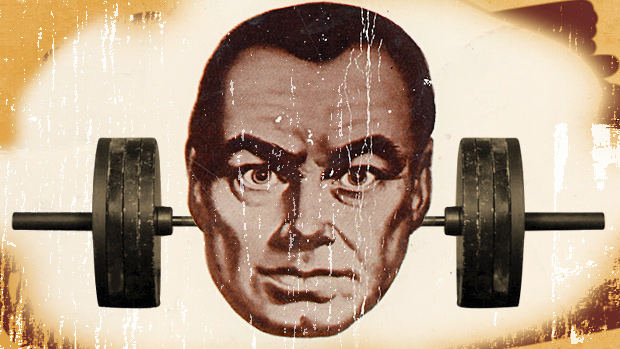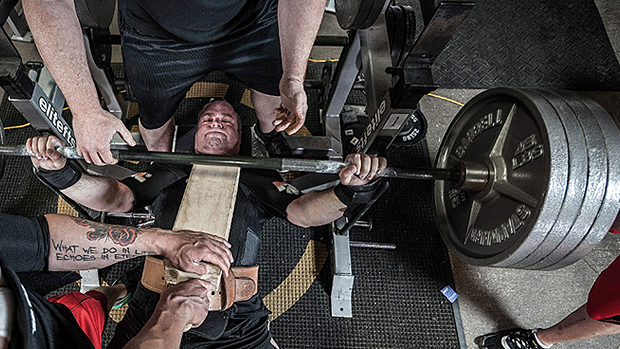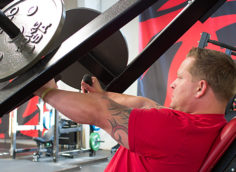What's the point of being big and strong if you're always hurting? Nobody cares about your deadlift numbers if you throw out your back every time you sneeze. And your barrel chest isn't very impressive if you can't lift your arms high enough to put on deodorant.
Sure, various bumps and bruises are inevitable, but training should enhance your quality of life, not detract from it.
Most of us begin lifting because we want to feel better, look better, and get strong. But why do so many of us forget about the "feel better" part? It doesn't mean you need to stop training hard. Strength and muscle are the cornerstones of resilience and longevity, and the best prehab and rehab method is smart training.
Choose exercises that build strength and muscle while simultaneously improving overall function. Here are seven of the best muscle-building, joint-sparing exercises that all lifters should be doing.
The barbell bench press is the king of all upper-body exercises, but it has a couple of drawbacks. For starters, it's not that great for pec development. Since the bar inevitably hits the chest on each rep, it restricts a full range of motion. So the pecs offer little to no help after the first third of the movement. It's also notorious for wrecking many lifters' shoulders.
While the dumbbell bench press is a worthy alternative, the squeeze press has shoulder-saving, hypertrophy-inducing benefits too. It involves squeezing two dumbbells together as hard as possible throughout the duration of each rep. The squeeze press has three advantages:
- It creates maximum tension. As opposed to relying on gravity alone, the squeeze press adds "inward" tension that amplifies the involvement of the chest, reinforces a strong mind-muscle connection, and lengthens time under tension to a skin-splitting degree.
- It helps with bench press mastery. It's a good teaching tool for the barbell bench press. For most lifters who aren't strength coaches, the classic cues that accompany the barbell bench press are gibberish. The squeeze press is arguably the best non-verbal tool for reinforcing factors like elbow positioning, full-body tension, lat involvement, and "bending" the bar.
- It's shoulder and wrist-friendly. The neutral grip and constant inward tension allow for more "wiggle room" in terms of external rotation and promote optimal shoulder packing/centration of the glenohumeral joint. Plus, the squeeze press doesn't require heavy loading to produce a meaningful training effect, which makes it a good option for lifters training around shoulder pain.
There's no denying that upper traps – the type that resembles two softballs on each side of the neck – puts the finishing touch on the power look.
Problem is, most lifters train the upper traps solely via scapular elevation, or "shrugging," despite the fact that their most vital function is upward rotation. Since upward rotation is one of three movements that the shoulder blades need to go through to lift the arms overhead, it's pretty important.
Most go-to trap exercises – namely, the barbell shrug and its derivatives – can do more harm than good for those who struggle with bad posture and overly depressed scapulae.
In particular, there are three red flags that occur upon the descent of a shrug: 1. The bar/dumbbells pull the shoulder blades down into scapular depression. 2. The upper traps are lengthened, which makes them less effective upward rotators. 3. The downward rotators of the scapulae become overactive.
Combine that with how they're most often performed – through a small ROM and with unnecessarily heavy loads – and the result is internally rotated shoulders, an inability to lift the arms overhead, and, consequently, a laundry list of postural problems, mobility limitations, and shoulder pain.
Overhead shrugs are a better way to train the traps. Here's why:
- They work the traps in alignment with their most vital function: upward rotation. Since the upper arms are abducted above 90 degrees, the overhead shrug puts the scapulae in an upwardly rotated position while still allowing for the same "shrugging" motion to occur.
- They're an exceptional trap builder. One of the best ways to hypertrophy a muscle is to isolate it while doing its true function. The overhead shrug fits the bill perfectly since it minimizes levator scapulae activity, a "shrug" muscle commonly associated with shoulder dysfunction, and isolates the upper traps more effectively.
- They're a game changer for shoulder health and performance. Overhead shrugs can be a godsend for individuals who can't lift their arms overhead since they strengthen all of the muscles that work on the scapulae (the upper, middle, and lower traps, as well as the serratus anterior) while promoting optimal overhead mechanics.
Most lifters have no business pressing a barbell overhead. Due to mobility limitations, a weak anterior core, poor posture, etc., overhead pressing (for most) is on par with hopping into the zoo's gorilla exhibit and punching the smallest one of the bunch square in the noggin. Sure, you feel strong in the moment... until you're forced to square up with King Kong's brother.
Luckily, the landmine press has become a godsend for lifters wanting to beef up their shoulders without disintegrating their rotator cuffs into an atrophied pile of dust.
But there's still a problem. While the one-arm landmine press (the most common variation) is an exceptional exercise, it becomes difficult to use heavier loads when other limiting factors set in. An alternative option is to interlock the fingers and press with both arms, but doing so changes the integrity of the exercise.
The two-arm landmine press (or Viking press, if you have the attachment) solves this problem. Here's Paul Carter doing the Viking variation:
It can be set up in a number of ways given some creativity (two landmines as shown in the first video, or two bars across the safety pins). Here's why it's worth doing:
- It's the most shoulder-friendly overhead press. The two-arm landmine press implements four shoulder-saving adjustments: 1. The neutral grip eliminates excess elbow flare. 2. The forward angle keeps the shoulders out of the last 30-50 degrees of flexion (the "danger zone"). 3. The likelihood of compensatory lumbar extension is greatly reduced. 4. You'll never feel the need to jerk your neck back to prevent the bar from taking out your chin.
- It's a phenomenal muscle builder. The reduced risk of compensation makes it easier to isolate the shoulders and control the movement. This will help you get a better mind-muscle connection. The result is more muscle in the shoulders, traps, and triceps.
- It improves overall shoulder function and overhead mechanics. The two-arm landmine press encourages more upward rotation of the shoulder blades, which goes a long way towards grooving optimal overhead mechanics and building strong, stable, and mobile shoulders. To boot, the added "reach" component strengthens the upper traps via upward rotation, their most vital function.
While no particular exercise is mandatory, the single-leg deadlift (SLDL) may be the one exception to the rule – especially if you want to add muscle to your flat-as-a-pancake glutes, show off your athletic prowess, and bulletproof your lower half.
Ironically though, many lifters are quick to dismiss SLDLs as a cute corrective exercise, despite the fact that those same lifters need eight ibuprofens to make it through a workout. Make no mistake about it though, SLDLs can (and should) be loaded up.
That's where the BANA method (bilateral assisted negative accentuated) comes in. It was popularized by Joel Seedman and involves doing the concentric (lifting) phase of an exercise with both legs – in this case, a deadlift – and the eccentric (lowering) phase with one leg.
It's a game-changer for two reasons. First, most people can handle 25-30% more load on bilateral exercises than unilateral exercises. Second, most people can handle 25-30% more load on the eccentric phase of an exercise than the concentric.
The BANA SLDL should be a mainstay in every training program. Here's why:
- It's arguably the most "functional" lower-body exercise. The hamstring group is stretched while working to stabilize the knee joint, the glutes are acting to extend the hip, the lumbar extensors are working to keep the spine in neutral, and the upper back has to stabilize the scapula while maintaining thoracic extension. So, the BANA SLDL will expose and address any weaknesses, asymmetries, and/or stability issues that fall under the radar during conventional deadlifts.
- It builds muscle and deadlift strength. The BANA SLDL is a surefire way to recruit the entire musculature of the lower half and pack on muscle in the glutes and hams. It's also a great way to refine hinge mechanics. The result will be a considerably stronger deadlift.
- It creates bulletproof movement mechanics and improves mobility. The eccentric portion of a movement allows for the most stability and control, which makes the BANA SLDL an effective way to clean up sloppy patterns and reinforce pristine movement mechanics. Plus, overloading the eccentric portion of the SLDL will do far more to address "tight" hamstrings than endless hours of toe-touching.
- It's a staple for athletic performance. The hips, pelvis, lower back, and core have to work as a single unit to maintain stability and keep you from falling over – while simultaneously generating force. This is exactly what happens when doing anything remotely athletic, like sprinting, changing direction, or jumping and landing on one leg.
You'd be hard-pressed to find many exercises that check as many "functional" boxes, but they're often thought of as being a fluffy, manhood-robbing corrective exercise.
As mentioned in 7 No-Barbell Strength Tests You Need to Pass, however, there are plenty of benefits to loading up TGUs, and I'd argue that holding a 100-pound ball of cast iron over your skull is as about as manly as it gets.
Here's why the TGU is a non-negotiable:
- It checks all the "functional" boxes. In one move, you're working on full-body strength, mobility, stability, athleticism, and movement efficiency, all while forcing your entire body to act as a single, functional unit.
- It carries over to the big lifts. The factors that need to be dialed in for a heavy TGU are extremely similar to those of a max-effort lift: full-body tension must be maintained to resist potential energy leaks, there needs to be constant leg drive, the body must maximize movement efficiency, and the entire midsection must retain a strong brace to facilitate maximal force production.
- It builds muscle – especially in the trunk. The TGU isn't a staple in most mass-building programs, likely due to the fact that it's too hard and there's not much eccentric stress involved. That said, the brutal isometric hold and extended time under tension that the shoulders, traps, forearms, glutes, and upper back must endure is no joke. Moreover, Bret Contreras's EMG studies found that, out of 52 common core exercises, "The TGU was the only exercise that had over 100% peak activation in all four core muscles."
Training through multiple planes of motion is a must. In particular, being able to move with strength and power through the frontal plane (side-to-side) is essential for anyone who plans on being a human being outside of the gym.
The lateral sled drag is essential since it's one of the only exercises that combines dynamic frontal plane movement with the ability to add meaningful load. Here's why it's so valuable:
- It trains single-leg strength in a lateral fashion. Frontal plane exercises like lateral lunges are great, but they involve zero movement through actual space. Lateral sled drags, on the other hand, train frontal plane single-leg strength in a dynamic fashion, and thus provide an entirely different training stimulus.
- It targets hard-to-reach muscles. There's a huge hip internal/external rotation component, which is hard to duplicate with load. Likewise, it's one of the few ways to build strength in both the adductors and abductors without using emasculating machines or schlepping through side-lying clams.
- It's a dynamic anti-rotation core challenge. Think of the Pallof press, an anti-rotation exercise, performed in a dynamic manner. This challenges the core more effectively than other dynamic core movements (like Russian twists) without placing undue stress on the spine.
- It's a knee and hip-friendly alternative. This is especially important for those with pain/injury. Since there's no rapid deceleration involved, the lateral sled drag is an effective alternative to other frontal plane exercises for people with tricky lower-body joints.
We usually categorize exercises like split squats and lunges as knee-dominant since they involve a "push" through the front leg. Likewise, exercises that involve a "pull" through the front leg are clearly hip-dominant.
But the Valslide reverse lunge is in a category of its own, and what it looks like – a knee-dominant movement – hardly matches up with what it feels like. In a way, it's a lot like the trap-bar deadlift in that it combines the best of the squat pattern with the best of the deadlift pattern, albeit in a unilateral fashion.
It delivers a number of unique benefits:
- It hammers the posterior chain. Since the back foot never leaves the ground, the front leg has to pull – not push – to bring the hips back into the starting position. This forces the glutes and hamstrings to work overtime.
- It recruits the quads in a novel way. Whereas there's a brief pause in tension during the stepping portion of other lunge variations, the Valslide reverse lunge involves constant tension since the back foot stays on the ground. And unlike lunges, it challenges the rear leg on both the eccentric portion of the movement (to maintain tension and control), and the concentric (to drive the knee forward against resistance).
- It's knee-friendly. There's not nearly as much knee flexion occurring in the rear leg, while the front leg hardly moves at all. This places significantly less pressure on the knees and makes it far easier to maintain a vertical shin.
- There's an added mobility component. The Valslide reverse lunge facilitates an active eccentric hip flexor stretch through a huge range of motion. This can improve hip mobility and lower-body function much more effectively than any passive stretch.





